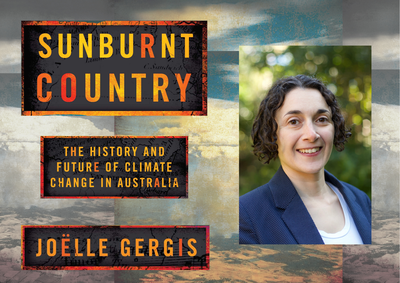Welcome to the Anthropocene: An Excerpt of 'Sunburnt Country' by Joëlle Gergis

Sunburnt Country pieces together Australia's climate history for the first time. It gives an unparalleled perspective on how human activities have altered patterns that have been with us for millions of years, and what climate change looks like in our own backyard. Here's an extract from Sunburnt Country, Part III - Time Travellers, Chapter 25.
The global cool period known as the Little Ice Age was brought to an abrupt end by the start of the Industrial Revolution. This marked the time when human activities started to have a noticeable impact on the Earth’s climate and ecosystems. Fuelled by coal, then oil, the inventions of railways and cars began connecting people across the globe. Medical discoveries saved millions of people from dying of infectious diseases, and soon the world’s population exploded. New artificial fertilisers meant that we could feed more people, and more of the Earth’s natural landscapes were cleared to support mass agriculture and livestock grazing.
By the 1950s, the great acceleration had begun. In a single lifetime, humans had grown into a force of nature. Globalisation, marketing, international tourism and financial investment helped fuel enormous economic growth. We now move more sediment and rock each year than all the natural processes like erosion and rivers. Greenhouse gas concentrations this high have not been seen in more than three million years, and have caused global temperatures to rise by nearly 1°C. We created a hole in our ozone layer by using a group of synthetic chemicals known as chlorofluorocarbons (CFCs), which were once used widely in refrigerants and aerosol propellants. Even though the use of CFCs has now been banned or is heavily regulated, the impact of their historical use remains with us.
We have altered the Earth’s natural cycles to the point that we have now entered a new geologic epoch dominated by humanity. The Anthropocene formally recognises that humans are now considered a geologic agent along with great forces of nature like erosion, volcanism and plate tectonics. We have modified the Earth’s surface and altered the chemistry of the atmosphere to the point where we have upset the equilibrium of a climate that has remained relatively stable for thousands of years. This relentless pressure on the planet now finds us on the unprecedented threshold of destabilising the conditions that allow life to exist on Earth. We are the first generation of people to realise the gravitas of bearing responsibility for maintaining a safe operating environment for humanity and the diverse life forms we share the planet with.
Recently I was involved in a study, led by Australian palaeoclimatologist Nerilie Abram, that showed that the Industrial Revolution kickstarted global warming earlier than we’d realised. To our surprise, our results showed that human-caused global warming began as early as the 1830s in the Northern Hemisphere. This redefined our understanding of when human activity began to influence the global climate. These findings were assembled from marine and land-based palaeoclimate records that extended back 500 years—well before the Industrial Revolution—to provide a critical baseline for the planet’s past climate, one that is impossible to obtain otherwise.
According to our evidence, all regions except for Antarctica are now showing clear signs of global warming. We know this because the only climate models that can reproduce the results seen in our palaeoclimate records are those that factor in the effect of the carbon dioxide released into the atmosphere by humans. By pinpointing the date when human-induced climate change started, we can then begin to work out when the warming trend broke through the boundaries of the Earth’s natural limits, because it takes decades for the global warming signal to emerge above natural climate variability.
Our landmark study, published in the scientific journal Nature in 2016, showed that warming did not develop at the same time across the planet. The tropical oceans and the Arctic were the first regions to show signs of warming as early as the 1830s. Europe, North America and Asia followed roughly two decades later. Southern Hemisphere temperatures increased much later, with Australasia and South America starting to warm from the early twentieth century. According to our evidence, all regions except for Antarctica show distinct and widespread warming.
While some parts of Antarctica have clearly begun to warm, a distinct warming signal over the entire continent is still not detectable. This is because the westerly winds that circulate through the Southern Ocean keep warm air masses from tropical regions at bay. Ozone depletion and rising greenhouse gas concentrations during the twentieth century have also caused this wind barrier to get stronger. The Southern Ocean currents that flow around Antarctica also tend to move warmer surface waters away from the continent, as colder deep water that hasn’t yet been penetrated by surface greenhouse warming upwells. But even though these ancient waters have not been exposed to the atmosphere for centuries, they are now warm enough to melt the underbelly of some west Antarctic ice shelves. According to Eric Rignot from the University of California, this process of ‘basal melting’ is now considered ‘unstoppable’ and will result in the irreversible retreat of a large sector of the west Antarctic ice sheet, as reflected by the imminent collapse of the Larsen C ice shelf reported in June 2017.
The delay in warming observed in the rest of the Southern Hemisphere is something we do not yet fully understand. But like Antarctica, the Southern Hemisphere’s oceans could be holding back warming—partly through winds and ocean currents, but perhaps also because of a process known as ‘thermal inertia’. This means that the ocean can absorb far more heat than the atmosphere or the land before it starts to warm. Essentially, the coolness of the Southern Hemisphere’s vast oceans acts to insulate Australasia and South America from the impact of surface warming. The question is, for how long?
If our evidence for delayed warming in the Southern Hemisphere holds true, it could mean that we are in for more climate surprises as global warming begins to overcome the natural buffering capacity of our surrounding oceans. Could the recent record warming of Australian waters, and the widespread damage to the Great Barrier Reef in 2016 and 2017, be an early sign that this is already occurring?
Global climate change policy set out in the United Nation’s Paris Agreement has the ambitious goal of limiting average global warming to 1.5°C above pre-industrial levels by the end of the century. In 2015, global temperatures crossed the 1°C threshold, and 2016 was 1.1°C above pre-industrial conditions. But there’s one major hitch. The baseline is relative to 1850–1900, when most of our thermometer-based temperature records begin. What our study shows is that for many parts of the world, that baseline may be an imperfect estimate of pre-industrial climate because human activities had already tainted the temperature record as early as the 1830s. As a result, the real baseline for a safe climate would actually need to be cooler than the most ambitious 1.5°C target currently on the table at international climate talks.
The small increases in greenhouse gases during the nineteenth century had a small effect on Earth’s temperatures, but with the longer perspective we gain from palaeoclimate records, we can see that big changes are possible. These fractions of a degree of extra warming might seem insignificant at first, maybe even trivial. But as we nudge ever closer to the 1.5°C guardrail thought to keep the Earth’s climate stable, the past tells us that even very small changes really do make a difference.


